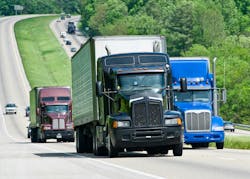Cracking the Emissions Management Code in Logistics
All eyes in the U.S. are once again on the emissions management space with the SEC recently handing out its long-awaited emissions disclosure guidance.
Reining in emissions has been a long-standing priority for all organizations throughout the business world as both internal and external pressure ramps up on organizations to “do the right thing” when it comes to their environmental impact.
However, gone are the days when vague corporate commitments to emissions reductions would suffice. Instead, organizations worldwide are now faced with ironclad legislative mandates that they either meet or run the risk of facing costly regulatory and reputational damage. Moreover, as the impacts of climate change become more acute, legislation is likely to become increasingly stringent, not less so.
With this state of affairs, business leaders worldwide are leaving no stone unturned when it comes to tamping down on their emissions footprints. And arguably no business vertical is facing greater scrutiny than transportation and logistics.
Logistics and transportation remain one of the most discernable contributors in relation to organizational emissions – accounting for over 10% of greenhouse gas (GHG) emissions. Without significant action, this share will likely grow as organizations continue to diversify their supply chains in hopes of avoiding similar disruptions like those stemming from the Covid-19 pandemic and the current global geopolitical upheaval.
Even with the SEC rule facing implementation delays, as state-level and international emissions laws – like California SB 253 or CSRD – introduce more ambitious emission reduction requirements such as Scope 3 reporting, clamping down on logistics and transportation emissions will remain a top organizational priority for many. However, with networks that stretch worldwide and operate 24/7, doing so is much easier said than done.
Yet, while this may be a daunting task, by focusing on a few key areas, businesses can make significant progress towards not just hitting today’s reporting requirements but putting themselves in the best position to cope with future legislation as well. Here are a few of these tentpole items that can propel companies towards emissions reporting success.
Double Down on Data
With an estimated 329 million terabytes of data generated worldwide on a daily basis, the sheer volume of data flooding into companies is proving to be challenging for even some of today’s most sophisticated data operators. In fact, 76% of organizations say they have trouble understanding their own data.
However, given how slow moving the logistics and transportation industries are when it comes to adopting technology and navigating change management, these businesses are particularly likely to struggle with today’s data management needs and regulatory demands. In today’s emissions regulation world, it is not only enough to have a partial data view or “ballpark” figures.
Regulators expect that businesses will have an end-to-end picture of their emissions across their entire network on a granular level that is easily actionable and detail the actions that have been taken, how progress is being made and ultimately whether they are compliant or not. Legacy tools simply are not capable of providing this level of oversight and intelligence. In addition, any of the insights and data that companies may have at their disposal are often siloed, meaning it is incredibly difficult for inter-department collaboration and visibility.
Therefore, the first step any logistics and transportation insider should take is to undertake a root and branch review of their data operations and establish a clear view on what the regulatory requirements facing them are and how well they are setup to meet them.
From there they can begin to formulate an effective strategy for how to make improvements in a methodical way that will limit adoption headaches and ultimately speed up an organization’s ability to generate the insights they need.
Modernize Routing
Collectively, transportation is the biggest emitter of GHG in the United States – optimizing routing can be a huge boon in getting emissions targets under control. When looking more narrowly at logistics related transportation emissions, nearly two-thirds of emissions stem from road-based freight.
So, routing has naturally become persona non grata for the logistics and transportation industries. That said, route optimization is often misperceived as only finding the shortest distance between two points. This is a part of the equation, however, the most effective route optimization efforts take a much broader and comprehensive approach to solving the problem.
For example, in addition to traditional routing considerations such as shipping distances, modern routing strategies need to have a clear read on the best way to limit idling and stops as much as possible as well. Dovetailing with these strategies is also the location of distribution centers so that businesses can ensure that trucks are picking up and dropping off full loads at each location, maximizing truckload capacity and reducing the number of trips that are carrying only a partial load or no load at all.
Focus on Facility Emissions
Buildings today account for nearly a third of global energy consumption, and as the backbone of logistics operations play a significant role in the sector’s emissions as well. Yet, distribution center impacts are often overlooked and routinely take a back seat in decarbonization conversations.
The priority list of emissions control factors that need to be taken into consideration in decarbonization efforts is vast and spans everything from the type of energy powering the facility to biodiversity impacts on proposed locations.
Moreover, businesses also need to think about future emissions demands as well, and factor in additional opportunities that might be available – such as installing solar or retrofitting with greener materials – to ensure that facilities can aid emissions control efforts both in the immediate and longer terms.
What does the future hold?
With a fragmented oversight landscape encompassing different demands across local, national and international jurisdictions, navigating today’s emissions regulatory landscape – let alone tomorrow’s – is proving to be a handful for even the best resourced organizations.
Amid surging stakeholder, investor and public demand, the push for emissions reduction and decarbonization will remain a huge priority for logistics and transportation sectors as organizations not only come to terms with the moral obligation of reducing climate impacts but the fact that sustainability is good for organizational growth.
Adapting to change can be daunting. However, with 67% of supply chain organizations saying they now have some sort of formal digital transformation policy in place, if leaders do not act quickly to adopt new methods for climate reporting, tracking and mitigation, not only are they more likely to face regulatory fallout but they will be left further and further behind as competitors become more comfortable with technology following years of stagnate investment in innovation and change management.
This means the pressure is on for logistics and transportation leaders. But, if leaders can focus on these few key priority areas, they will be able to build an actionable infrastructure that will drive emissions reduction success for decades to come.
William Theisen is CEO of EcoAct North America.
About the Author

William Theisen
As CEO for EcoAct, an Atos company, for North America with 14 years’ of experience in sustainability, William leads a team of experts supporting Global and Fortune 500 companies to develop and implement net-zero strategies. This includes managing projects for the private sector at any stage of their sustainability journey, including assessing emissions both direct and throughout the supply chain, setting and creating roadmaps for Science Based Targets (short term and net-zero), climate scenario analysis, and alignment with reporting frameworks and guidelines (CDP, TCFD, SASB). At EcoAct, we also develop carbon offsets projects (Nature and Technology Based Solutions) and support companies in procuring high quality carbon offsets to achieve their carbon neutral goals.
Currently based in NYC, William has an MBA from HEC – Paris has worked in sustainability and carbon offset project development while based in the USA, France, Mali, and Cambodia.
